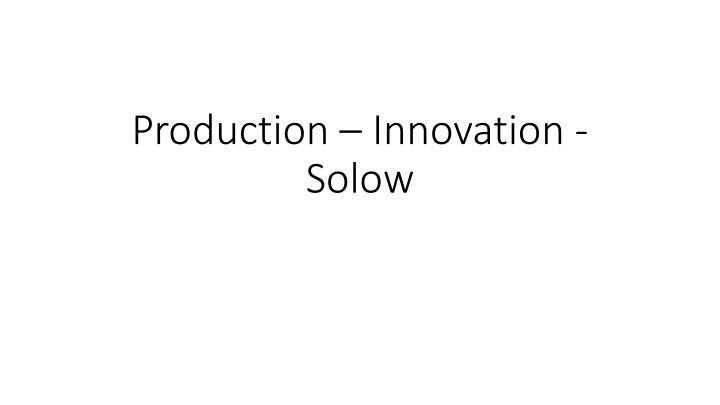
Production Innovation and Technological Progress in Economics
Explore concepts like isoquants, Hicks Neutral Technological Progress, and factors impacting production efficiency in economics. Learn about how the Marginal Rate of Technical Substitution influences labor and capital usage. Dive into Solow Graphs and strategies to increase productivity in economic systems.
Download Presentation

Please find below an Image/Link to download the presentation.
The content on the website is provided AS IS for your information and personal use only. It may not be sold, licensed, or shared on other websites without obtaining consent from the author. If you encounter any issues during the download, it is possible that the publisher has removed the file from their server.
You are allowed to download the files provided on this website for personal or commercial use, subject to the condition that they are used lawfully. All files are the property of their respective owners.
The content on the website is provided AS IS for your information and personal use only. It may not be sold, licensed, or shared on other websites without obtaining consent from the author.
E N D
Presentation Transcript
Production Innovation - Solow
Isoquants Capital (K) ? = ?(?,?) 18 The slope of the isoquant: Marginal Rate of Technical Substitution (MRTS)= ? ??? 100 ?= ??? Q=300 3 100 Q=200 Q=100 4 48 Labor (L)
Hicks Neutral Technological Progress t to t+1 (MRTS)= ? ?= ??? Capital (K) ??? ? = ?(?,?) The progress has equal impact on ??? and ??? so slopes are unchanged or ??= 200,??+1= 210 ??= 100,??+1= 110 ??+1= 100 Labor (L)
???increases by a greater factor than ??? ??= 100 ??+1= 100 Capital (K) ? = ?(?,?) Bigger impact when using a lot of K and a small amount of L The denominator increases by a greater factor than the numerator (MRTS)= ? ?= ??? ??? Smaller impact when using a small amount of K and a lot of L Labor (L) Sometimes called labor sparing . If ??? ? ? ,??? ??? ????????? ??? ?? ???????? ??? ? ??? ? ????????,??? ????????? ?? ?????????? ????? ??? =???
???increases by a greater factor than ??? Capital (K) ? = ?(?,?) Smaller impact when using a lot of K and a small amount of L The numerator increases by a greater factor than the denominator (MRTS)= ? ?= ??? ??? Bigger impact when using a small amount of K and a lot of L ??= 100 ??+1= 100 Labor (L) Sometimes called capital sparing . If ??? ? ? ,??? ??? ????????? ??? ?? ???????? ??? ? ??? ? ????????,??? ????????? ?? ?????????? ??????? ??? =???
Solow Graphs ? ?? 1 ? ??= ?? ?? ? ?? ??= ?? ?? ?? ? ??= = ?? ?? ??+1= ??+ ?? ?? ? ?? ? ?? ??+1= ??+ ?? ?? ?? ??= 1 ?? ?? ? ? ?? ? ??
y y= ? ?? ? ? + ? ? s ? ?? ? k
Increase savings rate s to s y y= ? ?? ? ? ? + ? ? s ? ?? s ? ?? ? ? k
y= ? ?? Increase Factor Productivity ? to ? y ? y= ? ?? ? ? + ? ? s ? ?? s ? ?? ? ? k
y y= ? ?? ? y= ? ?? ? y= ? ?? ? ? + ? ? s ? ?? s ? ?? s ? ?? ? ? ? k
Capital Cross country Solow application y y ? ?? ??= ?? ?? ? ??= ?? ?? ?? ??+ ?? ?? ??+ ?? ?? ? ? ?? ?? ?? ?? ?? ?? ?? ?? k k k
Capital and Technology Transfer ?? Capital and y y ? ? ?? ??= ?? ?? ??= ?? ?? ? ??= ?? ?? ?? ??+ ?? ?? ??+ ?? ?? ? ?? ?? ?? ?? ?? ?? ? ? ?? ?? ?? ?? ?? k k k
